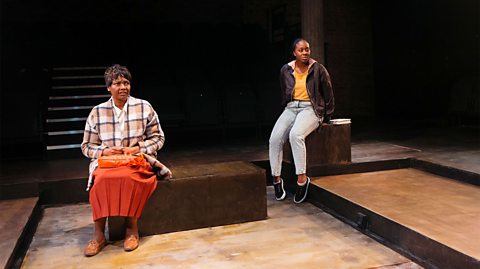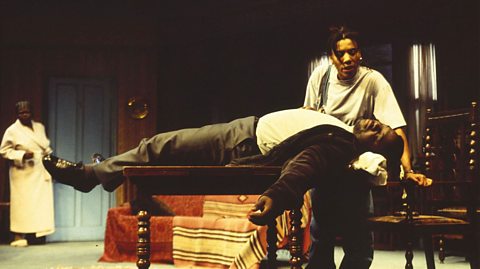Key points

Leave Taking is written as a play and intended to be performed.
It is a realist play, which means it focuses on the everyday lives of ordinary people.
The narrative of the play is linear, which means all the scenes are presented in chronologicalChronological means following the time order in which events happened. Stories told chronologically start with the earliest event and end with the last. order.
The author, Winsome Pinnock, uses a range of language and dramatic features to fully develop characterisation.


Remember
It is important to talk about the effects of language and dramatic techniques, as well as identifying them.
Use of form
Leave Taking is a play. It can also be referred to as a drama. It is intended to be performed, not just read.
A play can use time very effectively.
- Changes in sound and lighting can show a move from day to night without any description or dialogue.
- A moment can be frozen on stage and the audience can see lots of details simultaneously, without the need for lots of written description.
- Actors can control the pace of the dialogue, whereas a reader of a novel can read as slowly or as quickly as they want.
- A play can also establish many aspects of a character quickly through their costume and facial expressions.
Leave Taking is a realist play, which shows most of the action happening in real time to ordinary people. Its messages are mostly presented through characterisation, instead of a series of inciting incidentsEvents or moments that spark the main action in a story..
Leave Taking could also be categorised as a domestic dramaA play that focuses on the everyday lives of ordinary people. .
Question
What makes plays different to novels?
| Plays | Novels |
|---|---|
| shared experience for the audience | usually a solitary experience |
| immediate reactions from the audience | delayed or no access to reactions from others |
| scene is set immediately | setting the scene can take time |
| character information needs to be inferredto have worked something out from evidence and logic instead of explicit statements. | character information can be explained in detail |
| jumps in time need to be explained through expositionpresentation of background information or explanations, usually through dialogue | jumps in time can be signalled with just a few words |
| tone, mood and movement are conveyed through stage directions | tone and movement are conveyed through adverbs |
| the pace is controlled by the script and the actors, including pauses and breaks | the pace is controlled by the speed of the reader |
Use of setting

There are just two stage settings in Leave Taking:
- Maiâs bedsit
- Enidâs living room.
There will be visual similarities between the two settings, as both are apartments in 1980s London. However, Pinnock uses stage directions to signal clear differences between the two settings. Maiâs bedsit is "very messy" with "playing cards scattered all over". In contrast, our first impression of Enidâs home in Scene Two shows Enid "cleaning up, scrubbing at the floor".
The play moves back and forth between the two settings, with each one having a symbolic power. Maiâs home represents liveliness, creativity and freedom, whereas Enidâs home represents order, hard work and respect. It is not surprising to the audience when Del moves to Maiâs as, despite her attitude in Scene One, it is clearly somewhere where she feels more âat homeâ.
Lighting is also important to both settings. Some scenes are in partial darkness, symbolising grief or loss, which is especially evident after Enidâs mother dies.
Even though there are many allusionsreferences to something without mentioning it explicitly. to Jamaica and the Caribbean, there are no scenes set there. This keeps the audience grounded in the reality of the London setting and means that our judgements about life in Jamaica are limited to what the characters say.

Mini quiz
Use of structure

Leave Taking is split into eight scenes. There is no division into acts which enhances the realist feel of the play.
Pinnock does not specify an interval, but most productions place it after Scene Four after Enid reflects on her mother's death, inviting a pause for audience reflection. Scene Five takes place a few weeks later.
Changes between scenes are shown through changes in setting, lighting and character positioning.
There are temporal elisonsblocks or sections of time that are not included in the narrative presented on stage. where events happen off-stage, for example when Brod wakes up at Maiâs the night after an argument with Enid. Characters who never appear on stage, such as the Pastor and Enidâs sister Cynthia, are used to move the plot forward.
The narrative is linear, with no flashbacks. This enhances the realism of the play.

Mini quiz
Use of language
Leave Taking uses different aspects of language to convey a range of messages.
Jamaican dialect/patois

All characters use patoisA form of language or dialect different to the standard or official language of a country. throughout the play, sometimes for emphasis or to assert their identity. An example is Brodâs description of another Jamaican migrant as:
Man mad walk street no shoes, no socks, shirt open down to him navel.
Patois is sometimes used in the play to show strong emotions in a character. Additionally, it gives the characters more ways of expressing themselves than in Standard Englishthis is the form of English that is the most widely recognised, with fixed rules about spelling and grammar. It is used in most formal situations..

Tone
Actors and directors can interpret the lines of the play in many ways. For some lines, the playwright will carefully shape the tone so that their intentions remain clear. This line, from Del, is a good example:
Here we go again. I'll make breakfast.
The first sentence suggests a dismissive tone, maybe even with Del rolling her eyes. The second sentence tells us that Del is more amused than angry, as she then takes responsibility for a caring action. This use of tone gives complexity to Delâs character and shapes the audienceâs impression of this moment.
Stage directions and pauses
Stage directions are another tool for playwrights to use to make sure that their vision of the play is clear to actors and directors.
Most of the stage directions in Leave Taking are practical, showing when a character should enter, or when they should pick up a prop. At other times, they add meaning to the words being spoken.
For example, the stage direction "It isn't easy for Enid to say what she has to say" gives the actor and director clear instructions about how carefully Enidâs next line should be delivered and how difficult she is finding the conversation.
Pinnock indicates where there should be short pauses in the dialogue too. For example, in Del's line:
I'll get dressed. (Beat.) I couldn't sleep.
The "beat" is a short pause which suggests a change of attitude or a shift to a different type of conversation. Pinnock uses this stage direction at key moments throughout the play.
Analysing language
When writing about the language of a play, it helps to look at a small extract first.
Read the extract more than once to make sure you have fully understood it.
When you are reading the extract, highlight key words and short phrases that you think you could explain the effect of.
Think about similar examples of language elsewhere in the play.
Writing your ideas about language down in short sentences or on a mind map can help your revision.
Question
Read the extract below.
"Not that nibbling English lunchtime hunger. I talking âbout the sort that roar in your belly day and night till you think you going mad with the thought a food. You think is easy living off the land? The land fail you, you might as well be dead."
What does the language in this extract tell us about Enid?
(You could write down or create a mind map of your ideas.)
Some ideas might include:
The understatement in the metaphora word or phrase that describes something by saying it is something else. "nibbling" linked to food suggests that Enid thinks her daughterâs life is easy
The description "English lunchtime hunger" implies that Enidâs tone is mocking because her daughters donât properly understand what it feels like to be really hungry
Enidâs use of patoisA form of language or dialect different to the standard or official language of a country. in "I talking" shows how she wants to emphasise the truthfulness of what she is describing
The animalistic metaphor "roar in your belly" highlights the power that the memory of hunger has over Enid
The use of a rhetorical questiona question asked to make a point, rather than get an answer. reinforces the idea that Enid believes her daughters take their lives for granted, repeated throughout the play
The hyperboleexaggeration for effect. in the extract suggests that Enid now feels strongly that she needs to tell her daughters more about life in Jamaica and her reasons for leaving.
Dramatisation
The words written by the playwright form the foundation for how the director and actor interpret the text, as well as the choices made for lighting, costume, scenery, and other technical elements.
Three of the most important aspects of dramatising a play are casting, performance and staging.
Casting
One of the first jobs for the director of a play is to choose a cast. Pinnock is imprecisevague or not exact. about how her characters look, only giving clues about their ages, relationships, and a few items they have in their homes. This gives the director more freedom when casting and can be helpful if, for example, they want to update the setting from the 1980s to the present day.
Leave Taking has an ensemblea cast of actors where each one has a roughly equal amount of time on stage. cast, which means that the cast members must work well together and be clear about their charactersâ relationships with one another as they have roughly equal amounts of time onstage They must be able to convey a range of emotions, especially Del and Enid, who change the most.
Question
Look at these three images from different productions and rehearsals of Leave Taking. Which characters do you think are in each image and why?

Left to right: Mai, Brod and Del.
The costumes suggest an age difference between Mai and Del. Maiâs costume also tells the audience she is at home and has just woken up, and is therefore dressed more casually. This moment is from the start of Scene Seven, where Mai and Enid discover Brod asleep on Maiâs table.

Left to right: Enid and Viv
Enid is dressed smartly as always, and the actor looks the right age to be Vivâs mother. Viv is wearing casual clothing suitable for a teenager. They are both seated, suggesting a calm tone and a stable relationship, though Viv appears to be slightly worried. Vivâs position behind Enid on stage also implies that she is happy to be led by her mother.

Left to right: Enid and Del
The body language between the actors is the biggest clue to the characters and their relationship. Enid has her arms folded and her eyes looking away, while Del is leaning towards Enid and in a position that suggests she is expressing herself vocally and angrily. This moment is taken just before the end of Scene Three, after which Del walks out of her family home for good.
Performance
In rehearsals, the director and actors will look closely at language and stage directions. They will build up a sense of how they should each move around the stage, and their tone of voice. They will also have to be clear on what motivates their character and how they interact with others. The key themes of the play will be considered.
Staging
Pinnock includes clear instructions about specific props, pauses and changes in lighting. The rest is left to the interpretation of the director.
The play takes place mostly in real time and in two similar locations. Both settings are realistic and allow space for characters to move around and have engaging conversations. The most detailed information is the description of Maiâs bedsit at the start of the play. This tells us a lot about Maiâs character, but it also gives the audience an idea of why Enid is there, and why Del and Viv do not take Mai seriously at first.
Pinnock does not give us specific details on most of the charactersâ costumes, which can help modern-day directors reimagine the play for a new audience. Alternatively, using costumes that would be typical in the 1980s can help the audience understand that the play is an older text, set in a different time and with a contemporarybelonging to the same time period that the play was written in. context.
Quiz
Test your knowledge of the language, structure and form of Leave Taking by taking this multiple-choice quiz.
More on Leave Taking
Find out more by working through a topic
- count1 of 5

- count2 of 5

- count3 of 5
